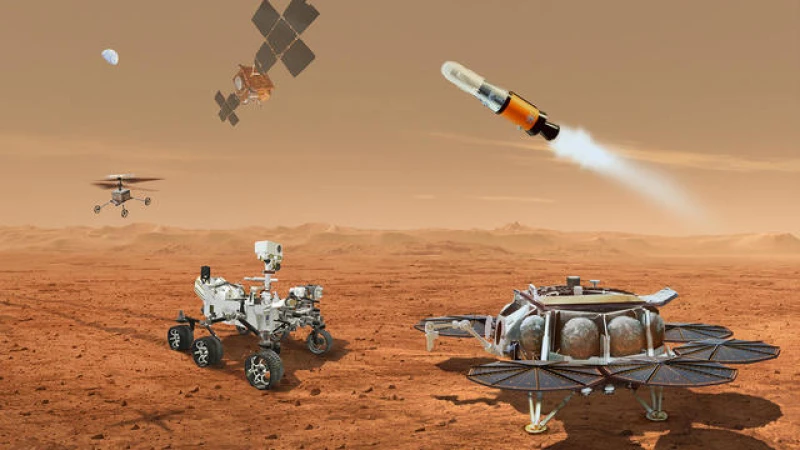Following an independent review of NASA's ambitious Mars Sample Return mission, agency officials announced on Monday their plans to solicit new ideas from agency engineers, researchers, and the private sector to develop alternative mission designs. This initiative aims to control escalating costs and expedite the return of valuable samples to Earth.
The independent review board's assessment from last September revealed that the intricate multi-spacecraft sample return mission could potentially cost up to $11 billion to execute. This projected cost is $4 billion to $5 billion higher than the initial estimates, and the mission may not retrieve samples back to Earth before 2040, even with extended development timelines.

The agency deemed the estimated price tag, which could reach $11 billion depending on the chosen strategies, as "unacceptable." The original cost target set by a National Science Foundation decadal survey that advocated for a sample return mission was slightly under $6 billion.
"The current budget constraints make it impossible to pursue an $11 billion architecture by 2040," stated Nelson. "So, what's the next step?"
Following the teleconference, SpaceX founder Elon Musk tweeted that the Starship rocket, which NASA Artemis astronauts will use to land on the moon in the coming years, "has the potential to bring back significant cargo from Mars in approximately 5 years."
No immediate response from NASA regarding Musk's statement.
The Mars Sample Return mission, or MSR, originally planned as the most intricate robotic planetary science mission to date, involves a new NASA lander delivering a rocket to the Martian surface to launch soil and rock samples collected by a rover on Mars.
Upon reaching Mars' orbit, the sample container would be retrieved by a spacecraft from the European Space Agency and returned to Earth for in-depth laboratory analysis to search for any traces of past microbial activity in ancient riverbed deposits.
NASA's original plan to launch the MSR mission in 2028 with a budget of nearly $6 billion has been deemed unfeasible. The independent review board cited unrealistic schedules, budget projections, and a management structure ill-equipped to prepare the spacecraft for launch on time.
The review panel estimated that the project would likely not launch before 2030 and could cost between $8.4 billion and $10.9 billion, depending on the final mission architecture. The review team emphasized that MSR is a priority for deep-space exploration for NASA in collaboration with ESA but was hindered by unrealistic budget and schedule expectations from the start.
The team highlighted the lack of a credible technical baseline, schedule, and cost that align with the available funding. They also pointed out technical issues, risks, and past performance indicating a slim chance of meeting the 2027/2028 Launch Readiness Dates. The potential launch readiness dates could be pushed to 2030 with sufficient funding and issue resolution.
To launch in 2030, the NASA sample retrieval lander and ESA's Earth Return Orbiter may require between $8 billion and $9.6 billion, with an annual funding of over $1 billion needed for three or more years starting in 2025.

Considering alternative mission scenarios and launching the sample retrieval rover and ESA orbiter on different timetables between 2030 and 2035 could lead to an MSR program that fits within annual funding constraints. However, costs may escalate to nearly $11 billion, surpassing the budget for the James Webb Space Telescope.
Nelson explained that a significant factor contributing to the rising cost was a billion-dollar reduction in NASA's science budget as part of a congressional agreement to secure funding for the debt ceiling. NASA allocated $310 million for the sample return mission in the agency's fiscal 2024 budget and intends to request only $200 million in the FY25 budget proposal while exploring mission options.
Regardless of how the mission unfolds, the samples will be ready. Since landing in Jezero crater in February 2021, NASA's Perseverance rover has been collecting soil and rock samples, storing them on board in sealed tubes or depositing them on the surface in known locations for future retrieval. These samples were gathered at or near an ancient delta where water once flowed into the crater, potentially containing evidence of past biological activity.
Although Perseverance is equipped with advanced instruments and laboratory equipment, its primary purpose is to assess habitability rather than directly search for evidence of past microbial life. To conduct in-depth research of this nature, the samples must be brought back to Earth.
In the proposed MSR strategy, a NASA rover would land near the Perseverance samples. Using either a robot arm or small helicopters, the rover would gather the samples and place them in a sample container on the Mars Ascent Vehicle, a solid-fuel rocket. The MAV would then launch into space and release the sample container into Mars orbit.
Subsequently, the European Space Agency's retrieval spacecraft would intercept the sample spacecraft, retrieve it, and head back towards Earth. Upon reaching Earth's atmosphere, the sample container would be released for a parachute descent to a designated landing site in the United States. Following this, the container would be transported to a laboratory at the Johnson Space Center for in-depth analysis.







